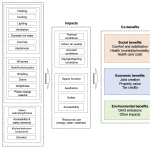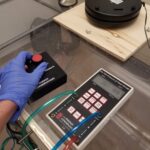
Dr. Sarah Haines
Principal Investigator
Sarah Haines is an Assistant Professor in the Department of Civil & Mineral Engineering and is the Director of the Indoor Microbiology and Environmental Exposures (IMEE) Lab.
Dr. Haines’ interdisciplinary research integrates building science, engineering, and microbiology to analyze connections between the built environment and human health. She uses cutting-edge microbiology techniques such as next-generation sequencing, metatranscriptomics, and bioinformatics to understand the impact of moisture on indoor environmental quality. Her work aids in understanding indoor exposures from microorganisms and chemicals providing for a cleaner and sustainable indoor environment particularly for our most vulnerable communities.
The Indoor Microbiology and Environmental Exposures Lab is made up of an interdisciplinary group of students from civil and chemical engineering, public health and social science. The IMEE Lab consists of both field-work but primarily wet-lab and incubation based experiments. The IMEE lab uses molecular methods and -omics approaches to perform advanced indoor environmental testing relating back to health and well-being of occupants. Students in the IMEE lab are trained to complete typical microbiological processes such as DNA/RNA extractions, digital and quantitative polymerase chain reaction (PCR) and bioinformatics techniques as well as utilizing filtration and air sampling equipment. Though it is still under renovation, the IMEE lab is designed for high containment level sample analysis consisting of an environmental sample preparation, extraction and storage station as well as cutting-edge quantification station equipped with cutting edge quantitative PCR and digital PCR technologies.
Team
Alumni
Projects

Co-benefits of residential retrofits: quantification and monetization approaches
This project explores the the non-energy benefits of implementing retrofits in residential buildings.

Estimating Indoor Airborne Concentrations of SARS-CoV-2
Using the quantitative filter forensics equation and metadata, along with RT-qPCR data from dust vacuumed off of portable air cleaner filters, I estimated indoor airborne concentrations of SARS-CoV-2 in covid-positive homes and in the community.

Housing issues in First Nations communities are widespread and well documented, this work aims to co-develop housing solutions for Northern Saskatechwan communities through a series of workshops.

At Home in the Arctic: Improving Housing Quality and Resident Health and Well-Being
Building performance optimisation and community engagement to improve the housing quality in the Northwest Territories.
Establishing a link between novel indoor mycotoxin exposure and potential human health outcomes
Publications
Journal Publications
Ruiz-Valero, L., Makaremi, N., Haines, S., Touchie, M.F., “Co-Benefits of Residential Retrofits: A Review of Quantification and Monetization Approaches,” Building and Environment, 270, (2025), 112576, doi: 10.1016/j.buildenv.2025.112576
Lyeo, J.S., Wong, M., Clyke, N., Big Canoe, B., Kinnear, P., Stopps, H., Spence, N., Haines, S.R. (2024). Ten questions concerning on-reserve housing challenges in Canada. Building and Environment.
https://doi.org/10.1016/j.buildenv.2024.111544
SummaryNastasi, N., Renninger, N., Bope, A., Cochran, S.J., Greaves, J., Haines, S.R., Balasubrahmaniam, N., Stuart, K., Panescu, J., Bibby, K., Hull, N., Dannemiller, K.C. (2022) Persistence of viable MS2 and Phi6 bacteriophages on carpet and dust. Indoor Air. doi: 10.1111/ina.12969
Rush, R.E., Dannemiller, K.C., Cochran, S.J., Haines, S.R., Acosta, L., Divjan, A., Rundle, A.G., Miller, R.L., Perzanowski, Croston, T.L., Green, B.J. (2022) Vishniacozyma victoriae (syn. Cryptococcus victoriae) in the homes of asthmatic and non-asthmatic children in New York City. J Expo Sci Environ Epidemiol. doi: 10.1038/s41370-021-00342-4
Haines, S.R., Hall, E.C., Katarzyna, M., Misztal, P.K., Goldstein, A.H., Adams, R.I., Dannemiller, K.C. (2021) Measuring microbial growth and volatile organic compound (VOC) emissions in carpet and drywall under various relative humidity conditions. Microbiome. doi.org/10.1186/s40168-021-01158-y
Hall, E.C., Haines, S.R., Katarzyna, M., Goldstein, A.H., Adams, R.I., Dannemiller, K.C., Misztal, P.K. (2021) Varying humidity increases emission of volatile nitrogen-containing compounds from building materials. Build Environ. doi.org/10.1016/j.buildenv.2021.108290
Renninger, N., Nastasi, N., Bope, A., Cochran, S.J., Haines, S.R., Balasubrahmaniam, N., Stuart, K., Bivins, A., Bibby, K., Hull, N., Dannemiller, K.C. (2021) Indoor dust as a matrix for surveillance of COVID-19 outbreaks. mSystems. doi: 10.1101/2021.01.06.21249342
Nastasi, N., Haines, SR., Xu, L., da Silva, H., Divjan, A., Barned, M., Rappleye, C., Perzanowski, M.S., Green, B., Dannemiller, K.C., (2020) Morphology and quantification of fungal growth in residential dust and carpets. Build Environ. doi.org/10.1016/j.buildenv.2020.106774
Viegas, C., Caetano, L.A., Cox., J., Korkalainen, M., Haines, SR., Dannemiller, KC., Viegas, S., Reponen, J. (2020) The effects of microbial diversity in human alveolar macrophage cell viability and inflammatory responses: the waste sorting industry exposure scenario. Environmental Research. doi.org/10.1016/j.envres.2020.109450
Haines, SR., Siegel, JA., Dannemiller, KC., (2020) Modeling microbial growth in carpet dust exposed to diurnal variations in relative humidity using the “Time-of-Wetness” framework. Indoor Air. doi: 10.1111/ina.12686. Highlighted on Feature Cover (front cover) of journal
*Bope A, *Haines SR, Hegarty B, Weschler CJ, Peccia J, Dannemiller KC (2019) Degradation of phthalate esters in floor dust at elevated relative humidity. Environ Sci Process Impacts. doi: 10.1039/c9em00050j. Nominated for inclusion in ESPI Best Papers collection; included in Emerging Investigator Series, highlighted on inside front cover of journal. *These authors contributed equally to the publication.
Haines S.R., Bope A, Horack JM, Meyer ME, Dannemiller KC (2019) Quantitative evaluation of bioaerosols in different particle size fractions in dust collected on the International Space Station (ISS). Appl Microbiol Biotechnol. doi: 10.1007/s00253-019-10053-4
Haines S.R., Adams, R. I., Boor, B. E., Bruton, T., Downey, J., Ferro, A. R., Gall, E., et al. (2019) Ten Questions Concerning the Implications of Carpet on Indoor Chemistry and Microbiology. Build Environ. doi.org/10.1016/j.buildenv.2019.106589
Zhang S, Shapiro N, Gehrke G, Castner J, Liu Z, Guo B, Prasad R, Zhang J, Haines SR, Kormos D, Frey P, Qin R, Dannemiller KC (2019) Smartphone App for Residential Testing of Formaldehyde (SmART-Form). Build Environ 148:567–578 . doi: 10.1016/J.BUILDENV.2018.11.029
Courses Taught
| Course Code | Title | Session | Instructors |
|---|---|---|---|
| CIV576 | Sustainable Buildings | Winter | Dr. Sarah Haines Dr. Jeffrey Siegel |
| CIV 440H1 | Environmental Impact and Risk Assessment | Winter | Dr. Sarah Haines |
| CIV 1298H | Indoor Air Quality: Moisture, Microbes and Materials | Fall | Dr. Sarah Haines |








